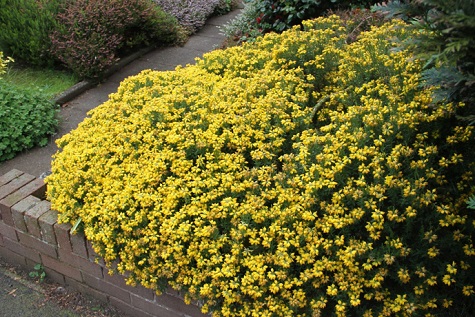This issue's Plant Focus is one of my favourite plants, Genista lydia, commonly known as the Lydia broom. It is a species of flowering shrub in the Fabaceae family, native to the Mediterranean region, specifically parts of Spain, Portugal, and Morocco.

A compact, floriferous yellow flowering shrub, low growing and robust, this beautiful cultivar is grown for its bright clusters of vivid yellow blossoms that flower for the whole summer.
This plant has masses of golden yellow, lipped flowers that appear on prickly, arching grey-green leaves in May and June and forms a compact natural dome is drought resistant, and makes an ideal companion to Mediterranean-style plants, particularly those with silvery foliage. It will also thrive in a windswept environment. It performs best on a sunny site with poor to moderately fertile soil.
No regular pruning is required. To care for the shrub take out dead and diseased branches after flowering. Replace straggly specimens with new plants.
To ensure that Lydian broom is at its best, choose a spot in full sun, with poor, well-drained soil. This sturdy flowering shrub is quite versatile and adapts easily, and it’s one of the rare cultivars that prefer conditions that are usually considered less than ideal for the majority of other plants.
Lydian broom can be planted in beds and borders, on slopes or even used as a colourful, vivid ground cover plant. This tough, versatile shrub will adapt to any location, and offer spectacular summer interest.

Here are some key characteristics of the Genista lydia plant:
Appearance: The Lydia broom is a deciduous shrub that typically grows to a height of 1 to 2 meters (3 to 6 feet) with a spread of about 1.5 to 2.5 meters (5 to 8 feet). It has upright branches covered in small, narrow, green leaves. The shrub produces an abundance of bright yellow flowers that bloom from late spring to early summer.
Yellow Flowers: The flowers of Genista lydia are its most notable feature. They are pea-like in shape and grow in dense clusters along the branches. The vibrant yellow colour of the flowers adds a splash of colour to the landscape.
Drought Tolerant: This plant is known for its ability to tolerate dry conditions and poor soil. It is well-suited for Mediterranean climates and can thrive in areas with low rainfall. Once established, it requires minimal watering.
Sunlight and Soil: Genista lydia prefers full sun exposure, meaning it requires at least six hours of direct sunlight each day to thrive. It can adapt to various soil types, including sandy, loamy, and clay soils, as long as they are well-draining.
Low Maintenance: The Lydia broom is generally low-maintenance and easy to grow. It doesn't require much pruning but can benefit from occasional shaping to maintain its compact form. Removing spent flowers can encourage more prolific blooming.
Wildlife Attraction: The bright yellow flowers of Genista lydia attract pollinators, such as bees and butterflies, which makes it a valuable plant for supporting local ecosystems.
When considering planting Genista lydia or any other plant, it's important to note that local growing conditions, climate, and regulations may vary. It's always a good idea to consult with local gardening experts or nursery professionals for specific guidance based on your location.
Most garden centres stock and sell this plant with costs ranging from £10- 30 depending on pot size or size of plant.